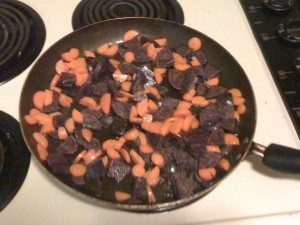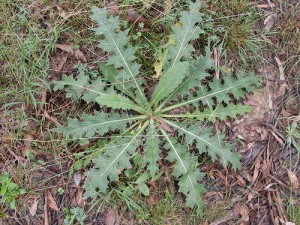
Unfortunately these purple potatoes aren't one of the Cornell breeds
A lot of people may not share my enthusiasm for the potato genome, hopefully you all enjoy eating potatoes. The stereotype of potatoes is lots of boring sameness one identical to the next.* Reality, as usual, is much more complicated. Tens of thousands of cultivars can still be found in the South American regions where potatoes were first domesticated. In America, breeders are constantly working to bring in desirable traits from those (often really cool looking) breeds and even wild relatives of the potato. They face both genetic barriers (species barriers are bad enough normally, but trying to introgress genes across a tetraploidy can be a mess) and consumer acceptance ones.
This was driven home in a story at the NYtimes about Cornell potato breeders who have developed breeds which grow much better in upstate New York, but run into problems because the potatoes look and taste different than the couple of varieties of potatoes consumers and restaurants are used to (most notably Idaho grown Russet Burbanks**). Cornell Extension has been working on overcoming that barrier providing the potatoes to restaurants and, in what I think is a genius move, culinary schools throughout the region.
If you happen to visit New York farmers markets take a moment to ask sellers about the breeds of potatoes they have for sale.*** The potatoes covered in the story are Salem, Eva (both white potatoes), Lehigh, Keuka Gold (yellow breeds), Adirondack Blue and Adirondack Red (both of which are just the color you’d expect from the name.) Purple potatoes in particular just look really cool, see image above.
*There was a saying about accepting differences that I vaguely remember from a childhood TV show, something along the lines of “People aren’t the same like potatoes, and that’s a good thing because potatoes are boring.”
**The Russett Burbank was developed by a truck gardener outside of New York City called Luther Burbank in the 1800s who was initially inspired to become involved in plant breeding by Charles Darwin’s 1868 The Variation of Animals and Plants Under Domestication. He later moved to California where he became famous plant breeder and, among other things championed the practice of grafting (connecting a cutting from one plant (usually a tree) to the stem of another, which, if done properly grows the two together and the cutting will grow flower and produce fruit like it would normally) a practice at the time condemned as unnatural. <– This info from Mendel in the Kitchen by Nina Fedoroff and Nancy Brown a great resource
***In fact, whenever you’re buying directly from a farmer, if you get a chance, ask about the breed of whatever you’re buying. More often than you’d expect there’s an interesting story about why he or she is growing that particular breed and where it came from.
